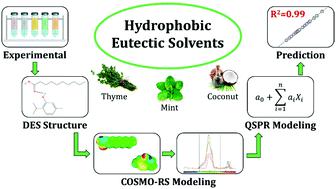当前位置:
X-MOL 学术
›
Green Chem.
›
论文详情
Our official English website, www.x-mol.net, welcomes your
feedback! (Note: you will need to create a separate account there.)
Predicting the density and viscosity of hydrophobic eutectic solvents: towards the development of sustainable solvents
Green Chemistry ( IF 9.3 ) Pub Date : 2020-11-12 , DOI: 10.1039/d0gc03077e Tarek Lemaoui 1, 2, 3, 4 , Ahmad S. Darwish 5, 6, 6, 7, 8 , Ayoub Attoui 1, 2, 3, 4 , Farah Abu Hatab 5, 6, 6, 7, 8 , Nour El Houda Hammoudi 1, 2, 3, 4 , Yacine Benguerba 1, 2, 3, 4 , Lourdes F. Vega 5, 6, 6, 7, 9 , Inas M. Alnashef 5, 6, 6, 7, 8
Green Chemistry ( IF 9.3 ) Pub Date : 2020-11-12 , DOI: 10.1039/d0gc03077e Tarek Lemaoui 1, 2, 3, 4 , Ahmad S. Darwish 5, 6, 6, 7, 8 , Ayoub Attoui 1, 2, 3, 4 , Farah Abu Hatab 5, 6, 6, 7, 8 , Nour El Houda Hammoudi 1, 2, 3, 4 , Yacine Benguerba 1, 2, 3, 4 , Lourdes F. Vega 5, 6, 6, 7, 9 , Inas M. Alnashef 5, 6, 6, 7, 8
Affiliation

|
The interest in green and sustainable solvents has been dramatically increasing in recent years because of the growing awareness of the impact of classical organic solvents on environmental pollution and human health. As a solution to these issues, several greener and more sustainable solvents have been proposed in recent years such as the novel Hydrophobic Eutectic Solvents (HESs). HESs have many advantageous characteristics and could be considered as a potential replacement for both ionic liquids and classical solvents. However, choosing the right HES with the required physiochemical properties for a certain application is an extremely difficult task, especially since large-scale experimental measurements are expensive and time-consuming. Thus, the development of predictive models capable of estimating the properties of these solvents could be considered as a powerful tool in screening new green and sustainable HESs. This work presents two novel Quantitative Structure–Property Relationship (QSPR) models for predicting the density and viscosity of HESs using Conductor-like Screening Model for Real Solvents (COSMO-RS) based descriptors. The data set used includes all the experimental measurements reported in the literature up to the date of writing this work to ensure that the developed models are highly reliable and robust. The results show that the proposed models were excellent at predicting the properties of HES not included in the training set as R2 values of 0.9956 and 0.9871 were obtained for density and viscosity, respectively. This work presents an initiative towards the development of reliable models for predicting the properties of HESs as a means to promote an efficient solvent design approach that can aid in designing and simulating new processes utilizing these novel HESs.
中文翻译:

预测疏水共晶溶剂的密度和粘度:朝着可持续溶剂的方向发展
近年来,由于对经典有机溶剂对环境污染和人类健康的影响的认识不断提高,因此对绿色和可持续溶剂的兴趣已急剧增加。作为解决这些问题的方法,近年来提出了几种更绿色,更可持续的溶剂,例如新型的疏水共晶溶剂(HESs)。HES具有许多有利的特性,可以被视为离子液体和传统溶剂的潜在替代品。但是,为特定应用选择具有所需理化性质的正确HES是一项极其困难的任务,尤其是因为大规模的实验测量既昂贵又费时。从而,开发能够估算这些溶剂特性的预测模型可以被认为是筛选新型绿色和可持续性HES的有力工具。这项工作提出了两个新颖的定量结构-性质关系(QSPR)模型,用于使用基于实溶剂的类似导体的筛选模型(COSMO-RS)的描述符来预测HES的密度和粘度。所使用的数据集包括截至撰写本文之日为止文献中报告的所有实验测量结果,以确保所开发的模型高度可靠且可靠。结果表明,所提出的模型能够很好地预测训练集中未包括的HES的特性。这项工作提出了两个新颖的定量结构-性质关系(QSPR)模型,用于使用基于实溶剂的类似导体的筛选模型(COSMO-RS)的描述符来预测HES的密度和粘度。所使用的数据集包括截至撰写本文之日为止文献中报告的所有实验测量结果,以确保所开发的模型高度可靠且可靠。结果表明,所提出的模型能够很好地预测训练集中未包括的HES的特性。这项工作提出了两个新颖的定量结构-性质关系(QSPR)模型,用于使用基于实溶剂的类似导体的筛选模型(COSMO-RS)的描述符来预测HES的密度和粘度。所使用的数据集包括截至撰写本文之日为止文献中报告的所有实验测量结果,以确保所开发的模型高度可靠且可靠。结果表明,所提出的模型能够很好地预测训练集中未包括的HES的特性。所使用的数据集包括截至撰写本文之日为止文献中报告的所有实验测量结果,以确保所开发的模型高度可靠且可靠。结果表明,所提出的模型能够很好地预测训练集中未包括的HES的特性。所使用的数据集包括截至撰写本文之日为止文献中报告的所有实验测量结果,以确保所开发的模型高度可靠且可靠。结果表明,所提出的模型能够很好地预测训练集中未包括的HES的特性。密度和粘度的R 2值分别为0.9956和0.9871。这项工作为开发可靠的模型以预测HES的性能提出了一项倡议,以此作为促进有效溶剂设计方法的手段,该方法可以帮助设计和模拟利用这些新颖HES的新工艺。
更新日期:2020-11-18
中文翻译:

预测疏水共晶溶剂的密度和粘度:朝着可持续溶剂的方向发展
近年来,由于对经典有机溶剂对环境污染和人类健康的影响的认识不断提高,因此对绿色和可持续溶剂的兴趣已急剧增加。作为解决这些问题的方法,近年来提出了几种更绿色,更可持续的溶剂,例如新型的疏水共晶溶剂(HESs)。HES具有许多有利的特性,可以被视为离子液体和传统溶剂的潜在替代品。但是,为特定应用选择具有所需理化性质的正确HES是一项极其困难的任务,尤其是因为大规模的实验测量既昂贵又费时。从而,开发能够估算这些溶剂特性的预测模型可以被认为是筛选新型绿色和可持续性HES的有力工具。这项工作提出了两个新颖的定量结构-性质关系(QSPR)模型,用于使用基于实溶剂的类似导体的筛选模型(COSMO-RS)的描述符来预测HES的密度和粘度。所使用的数据集包括截至撰写本文之日为止文献中报告的所有实验测量结果,以确保所开发的模型高度可靠且可靠。结果表明,所提出的模型能够很好地预测训练集中未包括的HES的特性。这项工作提出了两个新颖的定量结构-性质关系(QSPR)模型,用于使用基于实溶剂的类似导体的筛选模型(COSMO-RS)的描述符来预测HES的密度和粘度。所使用的数据集包括截至撰写本文之日为止文献中报告的所有实验测量结果,以确保所开发的模型高度可靠且可靠。结果表明,所提出的模型能够很好地预测训练集中未包括的HES的特性。这项工作提出了两个新颖的定量结构-性质关系(QSPR)模型,用于使用基于实溶剂的类似导体的筛选模型(COSMO-RS)的描述符来预测HES的密度和粘度。所使用的数据集包括截至撰写本文之日为止文献中报告的所有实验测量结果,以确保所开发的模型高度可靠且可靠。结果表明,所提出的模型能够很好地预测训练集中未包括的HES的特性。所使用的数据集包括截至撰写本文之日为止文献中报告的所有实验测量结果,以确保所开发的模型高度可靠且可靠。结果表明,所提出的模型能够很好地预测训练集中未包括的HES的特性。所使用的数据集包括截至撰写本文之日为止文献中报告的所有实验测量结果,以确保所开发的模型高度可靠且可靠。结果表明,所提出的模型能够很好地预测训练集中未包括的HES的特性。密度和粘度的R 2值分别为0.9956和0.9871。这项工作为开发可靠的模型以预测HES的性能提出了一项倡议,以此作为促进有效溶剂设计方法的手段,该方法可以帮助设计和模拟利用这些新颖HES的新工艺。











































 京公网安备 11010802027423号
京公网安备 11010802027423号